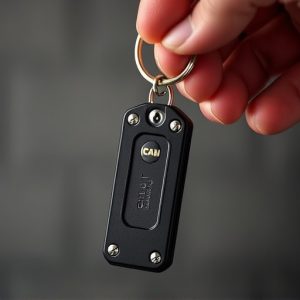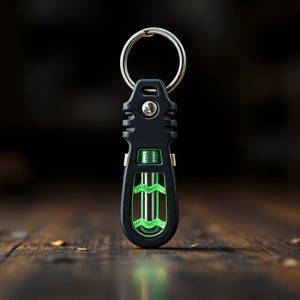Metal Keychain Defense Tools: Legal Safety Features for Responsible Ownership
Metal keychain defense tools, popular for personal safety, face varying legalities globally. Users m…….
Metal keychain defense tools, popular for personal safety, face varying legalities globally. Users must understand local regulations, which classify these tools as knives, firearms, or concealed weapons, to avoid legal issues. Prioritizing durability, sharp blades, and compliance with 'non-lethal' force laws ensures effectiveness and legality. Responsible ownership includes knowing legal definitions, uses, and storage practices, alongside self-defense training for safe handling and well-being of others.
“Uncover the world of portable keychain defense tools—compact yet powerful metal keychain weapons designed for personal safety. This comprehensive guide, ‘Understanding Portable Keychain Defense Tools,’ explores the legal considerations surrounding these devices and provides an in-depth look at safety features to ensure responsible ownership. From navigating regulations to choosing the right tool, we demystify keychain self-defense, empowering individuals to make informed decisions about their security while adhering to legal boundaries.”
- Understanding Portable Keychain Defense Tools: A Comprehensive Overview
- Legal Considerations: Navigating the Regulations Around Metal Keychain Weapons
- Safety Features to Look For in a Keychain Self-Defense Tool
- Responsible Ownership and Use: Ensuring Your Safety and Compliance
Understanding Portable Keychain Defense Tools: A Comprehensive Overview
Portable keychain defense tools have gained popularity as a convenient and discreet self-defense option for individuals seeking personal safety. These metal keychain weapons are designed to fit comfortably on a keyring, allowing users to carry them easily wherever they go. Understanding their features and legal implications is crucial before considering one as a personal defense mechanism.
Keychain defense tools often come in various forms, such as knifed-like devices, tactical spires, or impact weapons, each offering unique advantages. They are typically small, lightweight, and easy to operate, enabling users to defend themselves against potential threats quickly and effectively. However, it’s essential to familiarize yourself with local laws regarding the carriage of such tools, as regulations differ across jurisdictions. Knowing the legal boundaries ensures responsible use and prevents any legal repercussions.
Legal Considerations: Navigating the Regulations Around Metal Keychain Weapons
Navigating the legal landscape surrounding metal keychain defense tools is crucial for those considering carrying such devices as a means of self-defense. Each jurisdiction has its own set of regulations regarding hidden weapons, including keychain knives or other metal self-defense gadgets. It’s important to understand that what may be legally permissible in one region could be strictly prohibited in another.
In terms of metal keychain defense tools legal status, local laws often classify these items as either knives, firearms, or a separate category of concealed weapons. Regulations can vary widely—from strict bans on any form of hidden blade to more lenient rules allowing certain types of self-defense devices under specific conditions. Staying informed about your area’s legislation is essential to ensure compliance and avoid potential legal repercussions.
Safety Features to Look For in a Keychain Self-Defense Tool
When considering a metal keychain defense tool for personal safety, it’s crucial to look beyond its compact size and focus on integral features that ensure effectiveness and legality. These tools are designed to be easily portable, fitting comfortably on your keyring, but their small stature shouldn’t compromise performance or safety. Look for models featuring durable construction with high-quality metals like stainless steel, ensuring resilience against impact and wear. A sharp, robust blade is essential for penetration and self-defense, so check for a design that maintains a keen edge. Additionally, consider tools equipped with non-slip grips to ensure control during use.
Legality is another vital aspect. Metal keychain defense tools are subject to varying regulations depending on your location. Ensure the device complies with local laws regarding self-defense weapons, often classified as ‘non-lethal’ or ‘less-lethal’ force tools. Familiarize yourself with these regulations to avoid legal repercussions and ensure your personal safety tool remains a reliable option when needed most.
Responsible Ownership and Use: Ensuring Your Safety and Compliance
Responsible ownership and use of metal keychain defense tools are paramount for ensuring your safety and compliance with legal guidelines. Before carrying any self-defense weapon, familiarize yourself with local laws and regulations regarding hidden weapons or personal defense devices. This includes understanding the legal definition of a keychain weapon, its permissible uses, and where it can be openly or concealed carried. Respecting these rules not only protects you from legal repercussions but also fosters a safe environment for everyone around you.
Always store your metal keychain defense tools securely and out of reach of unauthorized individuals, especially children. Keep them in a locked drawer, safe, or purse to prevent accidental discharge or misuse. Additionally, consider attending self-defense training courses to learn proper handling techniques, safety measures, and when it’s appropriate to use such devices. Responsible ownership includes being mindful of your surroundings, knowing your rights, and always prioritizing the well-being of others.
Portable keychain weapons, or metal keychain defense tools, offer individuals a convenient way to enhance their personal safety. With the right features and responsible ownership, these compact devices can be valuable self-defense options. When choosing a keychain weapon, look for safety mechanisms like automatic lock mechanisms and impact-activated triggers to prevent accidental deployment. Understanding local laws regarding metal keychain weapons is crucial; ensuring legal compliance allows for open discussion about their effectiveness as a personal safety measure. Responsible ownership includes proper storage, regular maintenance, and adherence to guidelines, making these tools an informed choice for those seeking additional protection.


